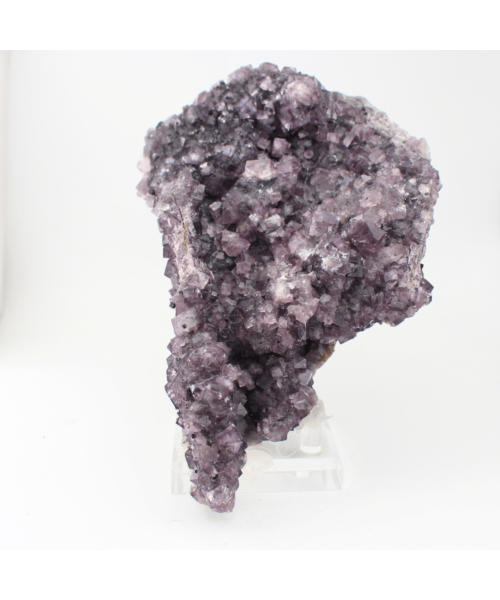Quartz x Tourmaline Naturally Terminated Himalayas 385g
Quartz x Tourmaline Naturally Terminated Himalayas 385g
Quartz: The Crystal Elegance of Earth's Embrace Quartz, an abundant and versatile mineral, graces the Earth's crust with its enchanting beauty and enduring presence. Celebrated for its crystal clarity, diverse colors, and multifaceted applications, quartz stands as a testament to the remarkable wonders of the mineral kingdom. Physical Characteristics: Color: Quartz exhibits a wide array of colors, showcasing clear (rock crystal), white (milky quartz), purple (amethyst), yellow (citrine), pink (rose quartz), and smoky gray (smoky quartz). These variations arise from differing mineral impurities during the crystal's formation. Transparency: Ranging from transparent to translucent, quartz crystals often showcase a remarkable clarity, allowing light to permeate and create a radiant glow. Crystal System: Quartz crystallizes in the hexagonal system, forming six-sided prisms terminated with pyramidal points. Varieties: Amethyst: Renowned for its rich purple color, amethyst is a cherished variety of quartz associated with tranquility and spiritual clarity. Citrine: Boasting warm yellow to golden-brown hues, citrine is linked to positive energy, creativity, and abundance. Rose Quartz: Exhibiting gentle pink tones, rose quartz symbolizes love, compassion, and emotional healing. Smoky Quartz: Characterized by a smoky gray to brownish hue, smoky quartz imparts an earthy and mysterious charm. Properties: Hardness: Quartz ranks 7 on the Mohs scale, signifying impressive hardness and resistance to scratching. Luster: Exhibiting a vitreous luster, quartz crystals gleam with a brilliant, glass-like shine. Density: With a moderate density, quartz strikes a balance between durability and weight. Applications: Jewelry: Valued for both its aesthetic appeal and durability, quartz is a popular choice in various jewelry forms, including rings, necklaces, earrings, and bracelets. Construction: Its hardness and resistance to weathering make quartz a key ingredient in the production of concrete, countertops, and various construction materials. Electronics: Quartz crystals serve as precision oscillators in electronic devices, ensuring accurate timekeeping in watches and facilitating communication technologies. Formation: Quartz forms in diverse geological settings, including igneous, metamorphic, and sedimentary rocks. It crystallizes from magmatic fluids, metamorphic processes, or precipitates from hydrothermal solutions. Locations: Quartz deposits are found globally, with significant sources in Brazil, Madagascar, the United States, and the Swiss Alps. Quartz, with its timeless allure, enduring strength, and kaleidoscopic beauty, remains a gemstone that seamlessly integrates itself into both natural landscapes and human creations. Whether admired for its inherent elegance or harnessed for its practical applications, quartz stands as a testament to the profound beauty found within the Earth's geological treasures.| Weight (Grams) | 385.000000 |
|---|---|
| Manufacturer | Imperial Time |
| Length (Depth) | 117mm |
| Width | 76mm |
| Height (mm) | 71mm |
| Main Stone | No Stone |
| Main Stone Creation | Natural |
| Total Carat Weight | 77ct |
| Number of Diamonds | 0 |
| Number of Gemstones | 1 |
| Gemstone | No Stone |
| Certification | Imperial Time UK Ltd |
| Year | 2024 |
| Seller Waranty | 12-month |
We aim to deliver within 1-3 working days, Monday to Saturday, once payment has been received.
Free Click & Collect on all orders We offer free click & collect across the UK (excludes Ireland and the Channel Islands). Delivery times may vary depending on the product you select. You will be provided with an estimated delivery date once your order is confirmed. In general, your order will be delivered within 3-6 working days from being dispatched. We will email you when your order has been processed and again when your order has been dispatched. For more details, Contact with us.
Returns, Refund and Cancellation Policy
We operate a returns policy for unwanted and faulty goods. Should you need to return any item to us for any reason please contact us first by telephone or e-mail - see our Contact page.
Unwanted Goods
Please return goods unused and in original packaging in perfect condition for resale within (14) days of receipt. We recommend obtaining proof of postage. A full refund (minus the shipping costs) will be made on receipt of the returned goods.
Please note that you are responsible for shipping costs when returning unwanted goods.
What our customers are saying
Do you Have any Questions?
I would like to buy this item. How do I proceed?
To purchase this item:
- Click on ‘Add to Cart’ and then, ‘Proceed to Payment’.
- Enter your billing details and click on ‘Continue’.
- Enter your card details and click on ‘Pay for order’.
- We will ship your order after your payment is confirmed.
How is my order secure?
All our items are appropriately packaged and sent using Royal Mail Special Delivery insured, to ensure they don’t get damaged during transit.
When will I receive my order?
- Free Next Day Delivery On Selected Items – Order by 11 AM for delivery the following day, Monday –Friday.
- Free Standard Delivery – We aim to deliver any order outside the UK within 2-3 working days.
What payment method can I use?
We accept the following payment methods:
- Debit Card/ Credit Card (for both watches and jewellery)
- Cash upon collection.














Please complete your information below to login.
Sign In
Create New Account